Peter MALONE
Saturday, 18 September 2021 19:43
Sixty Glorious Years
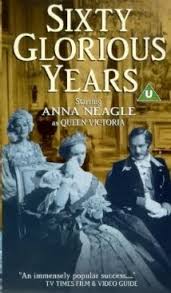
SIXTY GLORIOUS YEARS
UK, 1938, 95 minutes, Colour.
Anna Neagle, Anton Walbrook, C. Aubrey Smith, Walter Rilla, Lewis Casson, Felix Aylmer, Derrick de Marney.
Directed by Herbert Wilcox.
Aa sequel to Victoria the Great. Produced on the centenary of Queen Victoria's ascent to the British throne in 1937, the film was a tribute and a biography of the Queen. It was so successful that this sequel was made, highlighting aspects of the long reign and events in British history of the 19th. century.
Anna Neagle re-creates her role as the Queen under the direction of her husband, Herbert Wilcox. She was to make many films with her husband in the thirties, forties and right into the fifties. Anna Neagle was a musical comedy star but turned to biographies in the thirties and created quite a gallery of people. Here she acts well, showing the range of the young Victoria to the aging and dying Queen. Anton Walbrook is effective as Prince Albert. The film shows aspects of British parliamentary experience during these times and highlights such international events as the Crimean War and Sudan. Attractively photographed in the pageant style, the film gives some insight into the British styles of film-making in the thirties.
1. A British film of the thirties, style, manner, theme, stars? Its impact now?
2. The use of colour, pageantry, tableau re-creation of history, music? The atmosphere of the 19th century and of Victorian England, the court, the common people, politics, foreign affairs?
3. The effect of the film as a sequel? The centenary of Queen Victoria's accession to the throne? The atmosphere in 1937 and the memories of Queen Victoria? Anna Neagle and her status as a star of the thirties, her historical impersonations?
4. Comment on the choice of the selection of incidents to be presented in this pageant. From what point of view were they chosen, what did they illustrate about Victorian England?
5. Anna Neagle's characterization of Victoria as a person? As young, middle-aged and ageing? Was she a credible Victoria? As a woman, as queen? As seen in the preparations of her marriage, with Albert and the question of his secretary, the archery sequence, the confrontation with Peel and Wellington at the dance, the waltzing, her confrontation with Wellington about riding the horse, the more intimate scenes with Albert and her learning to be a wife as well as a queen? The background of the British royal family and the pressures on her?
6. The characterization of Albert, his love for Victoria, his German background and the general hostility and the way this was manifested for so long? His difficulties and subduing the queen? Co-operating with her? His interest in Dickens and reform and the hostile reaction of people. politicians and papers? The Crystal Palace project and the co-operation of Wellington, as something creative, Albert's vision for the 19th century and progress. the opening of the exhibition - acclaim and criticism?
7. The presentation of the times and the need for reform, the attitudes of the common people - so changeable? The Crystal Palace as a focus of this?
8. Albert's illness and the effect of his death on Victoria? How did the film build up their family life, the pageant of public life, home, Balmoral, their growing number of children? The effect on Victoria and the many years of her retirement and mourning? Was this reasonable? People's reaction? The effect on England? John Brown and his guidance of Victoria during this time?
9. How well did the film punctuate the narrative with historical episodes and their repercussions for example Crimea, the Sudan, General Gordon in Khartoum?
10. The pageantry and jubilation of the Jubilee and its effect on Victoria and people's response to her, in England?
11. The presentation of notable historical figures especially Palmerston, Gladstone, Disraeli - Palmerston and the Crimean War? Gladstone and the relief of Khartoum? Disraeli and the finance for the Suez shares?
12. The atmosphere of the death of Victoria and England not seeming the same, people speaking about her and the tribute to her, the meaning of her life in retrospect at her death and the beginning of the 20th century? What did Victoria achieve?
Published in Movie Reviews
Published in
Movie Reviews
Tagged under
Saturday, 18 September 2021 19:43
Six of a Kind
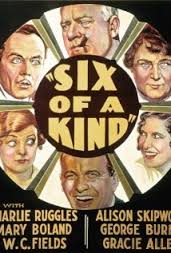
SIX OF A KIND
US, 1934, 65 minutes, Black and white.
Wesley Ruggles, Mary Boland, W.C. Fields, George Burns, Gracie Allen.
Directed by Leo Mc Carey.
A brief comedy typifying so much of thirties' comedy style: Wesley Ruggles and the harassed American middle-aged male, Mary Boland and the chattering dominating American housewife, George Burns and Gracie Allen with her incessant inane chatter, W.C. Fields and his routines. Leo Mc Carey who directed many of this kind of film including Marx Brothers' 'Duck Soup', went on to make such films as 'The Awful Truth' and 'Going My Way' amongst other popular comedies and films of sentiment.
1. The thirties' comedy and its style and conventions, appeal, the stars? Contrived? Dated?
2. Black and white photography, extensive use of studio sets for example the Grand Canyon? Artificial comedy?
3. The ironic touches especially with the title? What did the six have in common? The establishing of characters and types, farcical interludes and routines, the mocking of these American types?
4. Flora and Pinky - middle-aged marriage, fighting, making up, the memories of marriage and romantic dreams? The advertisement, Flora refusing to pay the money, the planning of the trip. George and Gracie and the dog and the continual harassment, the rooms and the inconvenience, the falling over the Grand Canyon, the encounter with the criminals, with Honest John? the need for privacy? The point behind their satirical presentation?
5. George and Gracie and the doad?pan humour, the mindless chatter? Dated comedy? The dog? The comedy of intrusion?
6. Honest John and his place in the town, Nevada? W.C. Fields and his routines especially the playing of pool, the investigations?
7. The minor characters from the people at the bank, the people in restaurants, hotels, the criminals? Briefly sketched for the purposes of the comedy?
8. The routines of visual humour, verbal humour, satire? A particular view of American characters and characteristics? The film as a picture of thirties' Americana?
Published in Movie Reviews
Published in
Movie Reviews
Tagged under
Saturday, 18 September 2021 19:43
Sitting Pretty
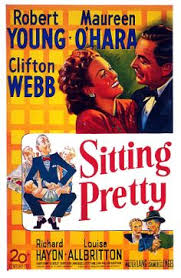
SITTING PRETTY
US, 1948, 83 minutes, Black and white.
Maureen O’ Hara, Robert Young, Clifton Webb, Richard Haydn.
Directed by Walter Lang.
Sitting Pretty is a classic comedy of the 40's, produced by 20th century Fox in their usual style, directed by Walter Lang who made similar films like The Jackpot Aad many musicals.
Maureen O’ Hara, a regular at Fox, is the attractive heroine with Robert Young as hero. The situation comedy and the poking fun at American suburbia still remains classic. Richard Haydn as an inquisitive gossip is particularly good.
However the main interest is the character of Lynn Belvedere played by Clitton Webb. Webb had been on stage but had returned to Hollywood in such. Dramatic films as Laura, The Razor's Edge. He turned to comedy in Sitting Pretty and for the next ten years or so made quite a number of comedies. There are the two Mr. Belvedere sequels: Mr. Belevederd Rings the Bell 1949 and Mr. Belevedere Goes to College 1951.
The film is enjoyable in itself but worth noting as a high point in Clifton Webb's career.
1. The film is considered a classic comedy of the forties. Why? Its impact now?
2. The conventions of the domestic comedy of the thirties and forties? Happy families, suburbia? The stars? The black and white photography? Dialogue, the brevity of the film? How well did they work together here?
3. How was the audience invited to identify with the people of Humming Bird Hill? The ordinary family and the harassment of the ordinary day, the children and their playing up (although lovable)? The picture of suburbia with the style of the houses, neighbours? The irony of the audience identifying and then suffering when Humming Bird Hill was exposed by Mr Belvedere?
4. The King family and the presentation of their domestic set-up, the detail of their ordinary life, the children?
5. The humour with the various helps being exasperated and leaving? The preparation and expectations for the coming of an assistant?
6. The screenplay's build-up of expectations about Lyn Belvedere? The audience, like the Kings, expecting a middle-aged woman? The humour of Clifton Webb's arrival and his presentation of himself as Mr Belvedere? Mr Belvedere taking command of the family and the film at his arrival?
7. The particular traits that Clifton Webb brought to his portrait of Mr Belvedere? His hating of children and his treatment of them especially with the porridge over the baby's head, discipline? His background and the humour of his having tried everything? The secret of what he did in his room and the Kings spying on him through the door, trees etc and his discovering them? His behaviour and the response of the suburb? People's curiosity especially Mr Appleton? His outings, the ambiguous situations with Tacy King? Dancing with her and the talking?
8. Mr Belvedere's presence and the gossip precipitating a breakdown of the King's marriage? The suspicions of Harry? Tacy and the child's illness and her returning home? The humour but showing the possibility of gossip making jealousy real?
9. Comment on the satiric portrayal of Mr. Appleton, his mother and their snooping, the dialogue given to these characters, the comeuppance they had when the book was published and they were satirized and their reaction?
10. The humour of the revelation of the novel, the sales, the suburban people wanting to see what page they were on, libel suits?
11. The humour of Mr Belvedere staying in control, his decision to stay?
12. The comic qualities of this film, its presentation of the American values and its support of them as well as its satire of them?
Published in Movie Reviews
Published in
Movie Reviews
Tagged under
Saturday, 18 September 2021 19:43
Sisters, The

THE SISTERS
US, 1938, 99 minutes, Black and white.
Errol Flynn, Bette Davis, Anita Louise, Ian Hunter, Donald Crisp, Beulah Bondi, Jane Bryan, Alan Hale, Dick Foran, Henry Travers, Patric Knowles, Lee Patrick, Laura Hope Cruise, Harry Davenport.
Directed by Anatole Litvak.
The Sisters was a popular film of 1938. Errol Flynn had been emerging in the previous three years as a romantic star and an action star, Captain Blook and The Charge of the Light Brigade. He was also to be Robin Hood. Bette Davis was emerging from smaller-budget films and was soon to film Dark Victory and The Private Lives of Elizabeth and Essex. She had won an Oscar in 1935 for Dangerous and was to win one in 1938 for Jezebel.
This is a film of early 20th century Americana, three sisters celebrating the re election of Teddy Roosevelt in 1904 until the election of President Taft in 1912. Two of the sisters settle in Montana and lead quiet lives. However, Louise, played by Bette Davis, goes off with a sports reporter, Errol Flynn, to San Francisco. However, he becomes involved in drinking and gambling and leaves for some time. There is a bittersweet ending.
The film has a great number of Warner Bros supporting character actors. It was directed by Russian/Ukrainian-born Anatole Litvak who directed Mayerling and Tovarich at this time, went on to direct Bette Davis in All This and Heaven Too. After World War Two he directed such films as The Snake Pit and Anastasia. In the 1960s he directed The Night of the Generals.
1. How enjoyable a melodrama of the thirties? The style of American romantic drama and its appeal? How good an example? A Bette Davis film? An Errol Flynn film?
2. The importance of the atmosphere of San Francisco, a costume melodrama, black and white photography, music, the set pieces of the earthquake, ball, wharves, newspaper life? An atmosphere of genuine Americana?
3. The emphasis of the title? The focus on Louise, in comparison with each sister? The use of the novel technique and the turning of the pages?
4. The importance of the society setting? People's manners, morals, the atmosphere of conventions of behaviour? Their influence on the main characters? Constricting them, rebellion against them?
5. The picture of women in the film? Women as wives, as working, the support to their husbands? The impact in the thirties? Modern response?
6. The picturing of the strengths of the characters, their weaknesses, the nature of mutual love and fidelity? How genuine, how ideal?
7. Louise as presented in this context, as a woman of her time? Her strong character and its illustration? Her love for Frank? The change that marriage wrought in her? Her fidelity? Louise as an ideal of sentiments and feeling? How convincing a character?
8. The portrayal of Frank? Errol Flynn in this role? As a person, his strengths and weaknesses, his creative ambitions, his search? His feeling that he was a corpse? His capacity as a writer, his job? His love for Louise, his dependence on her? The impact of his drinking? The details of his walking out on her and the melodramatic atmosphere? His escape? The change that his voyages made in him? The importance of the return? The genuine re-meeting of the two? Audience response to this happy ending?
9. The contrast of Louise with her sisters? The atmosphere of infidelity, society gossip, divorces?
10. The influence of Tim on Frank? The atmosphere of the newspaper world? The help that friends give and their work for reconciliation?
11. The influence of Benson in the film? As a contrast in character to Frank? His support for Louise and love for her? His ability to let her go back to Frank?
12. The importance of Louise's parents? Their frequent reappearance in the film? Their love for one another? Their influence on their daughters? Their concern?
13. Flora and her mother? The contrast with Louise? Yet the friendship? The importance of the earthquake and the aftermath for Louise's health?
14. The impact of the earthquake sequences? Flora and Louise in the earthquake, the ruins, fire, sickness? The impact of the quake on San Francisco?
15. What were the main humane themes of the film and how well were they explored?
Published in Movie Reviews
Published in
Movie Reviews
Tagged under
Saturday, 18 September 2021 19:43
Singing Nun, The
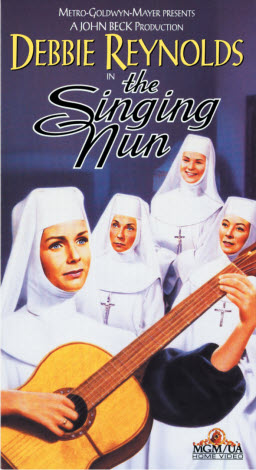
THE SINGING NUN
US, 1966, 99 minutes, Colour.
Debbie Reynolds, Ricardo Montalban, Greer Garson, Agnes Moorehead, Chad Everett, Katharine Ross, Ed Sullivan, Juanita Moore, Michael Pate, Tom Drake.
Directed by Henry Koster.
The Singing Nun is a cheerful musical – and it was released in the year following the success of The Sound of Music. (Singing nuns were parodied by Helen Reddy in Flying High 2.)
The film was based on the early life and career of Sister Sourire, the real Belgian singing nun. She was born Jeannine Deckers. The nun had a hit in 1963, ‘Dominique’. She also appeared on the Ed Sullivan Show and raised a great deal of money for Catholic causes.
At the end of the film, the sister leaves to go to work as a missionary in Africa, despite the hint of a possible romance with a school friend, played by Chad Everett. Greer Garson appears as the mother superior and Katharine Ross as one of the young women.
The real-life story of the sister is much sadder. The real sister did leave the convent, but she went to live with her long-time partner and Philips Records dropped her contract. She fell on difficult financial times and, in 1985, she and her partner committed suicide.
However, this is a Hollywood version of a popular story – and, at that level, is a very cheerful film.
1. How entertaining was this film? Why? A musical, comedy? Debbie Reynold's personality? Panavision and color?
2. Could the film be called religious? In what way?
3. What presuppositions about religion, nuns and their life, nuns and their work did the film have? Did it give a realistic impression? Or was it "the Hollywood type of religious film"? Sentiment was very strong in the film. Was the film sentimental? As regards the nuns' life, as regards Ann's working for the poor?
4. The film was loosely based on fact. Did the film give the air of reality? Or was it a fantasy kind of film?
5. What wore the main impressions that the nuns gave? As dedicated persons, as women, the quality of their religious life and work? How attractive was their way of life?
6. How did Debbie Reynolds fit into this atmosphere an Sister Ann? Was she convincing as a nun? The initial ride on the motor scooter, her taking over Samaritan House, her relationship with the nuns, especially Sr Mary, her relationship with the Prioress and Sr Cluny, the temptation of fame and working in records, her missionary work at the end? How attractive, how convincing?
7. How enjoyable were the songs? their purpose in the film? their impact on people ? the record company, the press presentations of Sr Ann, the Ed Sullivan Show? Are the songs attractive in themselves?
8. How interesting was the presentation of fame for a nun? The recording and TV atmosphere? This kind of world and the convent?
9. How real were the choices for Sr Ann? Were they well presented?
10. How real was Robert, as a character? As providing a convincing romantic interest in the film?
11. The importance of the sub?plot about Nicole and her brother? As a picture of the nun's apostolic work? Sr Ann's mistake in interfering? And yet the final dependence upon her? Was this genuinely moving?
12. The presentation of the Prioress ? Greer Garson style? Sr Cluny, Agnes Moorehead style? Sr Mary and the interst in an African nun?
13. How convincing was Father Clementi and his pushy character? His work as a priest, as a con?man, as a business agent?
14. How convincing was the ending with Sr Ann choosing the missions for her vocation?
15. The film got generally bad reviews. Were they warranted? Was the film made for popular audiences and not critics?
Published in Movie Reviews
Published in
Movie Reviews
Tagged under
Saturday, 18 September 2021 19:43
Sing You Sinners
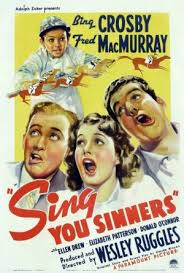
SING YOU SINNERS
US, 1938, 88 minutes, Black and white.
Bing Crosby, Fred Mac Murray, Donald O’ Connor, Elizabeth Patterson, Ellen Drew.
Directed by Wesley Ruggles.
Sing You Sinners is an entertaining musical, 1930s style. It was directed by Wesley Ruggles who directed quite a number of comedies and dramas in the 30s, and written by director Claude Binyon.
It is a surprise to see Bing Crosby, Fred Mac Murray and Donald O’ Connor as brothers (Mickey Rooney was initially contracted for the film but, having to make another film, Donald O’Connor? stepped in).
The three are the singing Beebe brothers (although Fred Mac Murray’s character dislikes the singing – preferring to work in his garage and support the family). Bing Crosby plays the lackadaisical type, more interested in horses and singing than in any kind of responsibility. Donald O’ Connor wants to grow up like him. Elizabeth Patterson is their concerned mother and Ellen Drew is Fred Mac Murray’s fiancée.
The film offers a great deal about home life in America in a small town in the 1930s. It holds up the ideals of regular work and responsibility rather than gambling and racing. However, the film has a lot of racing sequences and a presentation of the racing industry of the time.
Each of the three leads has an opportunity to sing. Bing Crosby had a lot of hits from this film. Donald O’ Connor shows the dancing flair which was to mark his career, especially in the 1950s and Singin’ in the Rain. He was to appear with Bing Crosby in the 1956 version of Anything Goes.
1. The film as an example of thirties entertainment? The values and the quality?
2. The impact of the stars, Bing Crosby and his singing?
3. The popular ingredients for American comedy? successes and failures, the pursuit of wealth and happiness? Traditional American values, their embodiment here?
4. The picture of small?town life, the town itself, people, the Beebe family, each of the individuals and their work, Joe's lack of work, the family relationships, Martha? Work, churchgoing etc.?
5. The film's theme of work and responsibility, preparing for the future, hopes and the need for money and security?
6. The film's comment on the kinds of work done by men? The reaction to playing music for a living? Working in a garage as being manly? Money and coming from horse?training? The comment on the seal lecture and Joe's getting Martha away from it etc.?
7. How well characterized was Joe? Bing Crosby's style, lack of work, burden on the family, attitude towards Martha? The reason for his decision to go to Los Angeles? The buying of the horse? His high hopes? The comedy in his various winnings on his first
arrival?
8. The film's presentation of the theme of family pride?
9. How important was the race climax, the hopes, the bribe, Joe's advice to Mickey, the final fight?
10. The final discussions about the future, how realistic? The mother's comment on the music, the horses, security?
11. The characterizations of Dave, Mickey, the mother, Martha? Credible and real characters?
12. The contribution of the music? The film as an example of the values that people stood for in the thirties, the picture of people and society, the impressions now?
Published in Movie Reviews
Published in
Movie Reviews
Tagged under
Saturday, 18 September 2021 19:43
Sinbad and the Eye of the Tiger
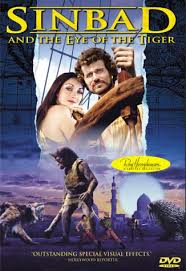
SINBAD AND THE EYE OF THE TIGER
UK, 1977, 113 minutes, Colour.
Patrick Wayne, Taryn Power, Margaret Whiting, Jane Seymour, Patrick Troughton, Kurt Christian.
Directed by Sam Wanamaker.
Sinbad and the Eye of the Tiger has excellent credentials – although, Patrick Wayne as Sinbad is rather lightweight compared with other Sinbad’s. Wayne is John Wayne’s son and the Princess Dione is played by Tyrone Power’s daughter, Taryn.
The story was based on an original story by Beverley Cross who was to create the story for The Clash of the Titans. Special effects as well as the story were contributed by Ray Harryhausen, the celebrated special effects expert who worked from the 1950s with such films as It Came From Beneath the Sea to much greater effects in the 1960s with Jason and the Argonauts and One Million Years BC. He continued to create all kinds of creatures for this kind of mythical film, concluding with The Clash of the Titans.
The film was directed by Sam Wanamaker, a Hollywood actor who was blacklisted and moved to the United Kingdom appearing in many films, directing and, most prominently, enabling the rebuilding of the Globe Theatre on the south bank of the Thames.
The action is familiar: Sinbad has to accompany a princess and her brother who has been transformed into a monkey in order to seek a wise man to find how the brother can be transformed. He then wants to marry a princess. However, the mother, Xenobia and a magician, have a control over the prince transformed into the monkey. There are various characters to be found on the way to the island and the wise man including a giant walrus, demons, a cat with sabre teeth.
The film is entertaining, the special effects excellent, the acting limited although this is an early film for Jane Seymour as Princess Farah.
1. Audience appeal for this kind of fantasy? quality of the plot and the production? its place in the series of Sinbad films, of Dynamation films?
2. The importance of colour, locations, sets, studio work? The Arabian nights' atmosphere? The contribution of the music? Costumes? How Important are for the enjoyment of this kind of film?
3. Dynarama, the techniques, the artificial reality of the effects? Audience interest in visual presentation, enjoyment of their effect within the film, the fight with the three, the Minotaur, his creation and his rowing of the boat, the baboon and its playing chess and behaving as baboon and human? Xenobia and her experience the bird, the trogladite, the final tiger and the battle? The special effects with the disappearance of Kassim at his coronation, the ship sequenece, the snow? The Aurora Borealis and the sequences at the source of life?
4. The entertainment of the plot, the Sinbad story, its fantasy, overtones of reality, dangers, goodies and baddies, wizards, power, the wise man Molanthus and his power? Heroes and heroines, princes and princesses? The quests, endurance, fights and courage?
5. The importance of the opening, coronation sequence and its splendour, the sinister use of eyes, power, danger? The explanation of the princess pleading with Sinbad, the prince?
6. The portrayal of Alabad, the credible and dashing bero, the encountering of the initial danger and the fighting? His men and their loyalty? The challenge of the princess, the undertaking of the voyage? Adventure Ingredients well presented?
7. The contrasts with Xenobia as villainess, the minister’s son, the creation of the Minotaur, the elements of pursuit with the two ships and their voyage?
8. the encounter with Digne? Her welcoming thm,, the discovery of Milanthos? Milanthos as a character, his humour, his believing their story, joining in their quest? the powers? The danger against Xenobia?
9. Xenobia and her turning into a bird, her spying, when she was reduced to a small size and captured, her escape? The magic potion? the horror and humour of her recovery at her webbed foot?
10. The two ships arriving in the new land, the long journey, mix Sinbadfor the quick journey for Xenobia and the confrintation? Their trek? The encounter with the trogladites? The door?
11. The buildup to the final fights, the death of her monster, restoration of Kassin and the romantic overtones? The buildup to Xenobia turning into the tiger? The battle with the trog and the paths of his death? The fight with Sinbad and the herolsm? The buildup to the applaud-winning death of the tiger?
12. The atmosphere of the happy ending, its being presented with the final titles? Audienced involvemnet with this kind of fantasy story? The basics of a good story, good adventure? The symbolism of basic moral values of the clash between good and evil?
Published in Movie Reviews
Published in
Movie Reviews
Tagged under
Saturday, 18 September 2021 19:43
Simba
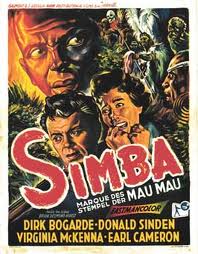
SIMBA
UK, 1955, 99 minutes, Colour.
Dirk Bogarde, Virginia Mc Kenna, Basil Sydney, Marie Ney, Joseph Tomelty, Earl Cameron, Orlando Martins.
Directed by Brian Desmond Hurst.
Simba was topical in 1955, a story of the Mau- Mau uprising during the years that it was happening in Kenya. It was filmed on location in Kenya itself and capitalises on the African locations and photography.
The film was a star vehicle for Dirk Bogarde who had emerged in the 1950s as Britain’s most popular matinee leading man. Adept at drama, portraying criminals, as well as comedy, he showed great versatility in the 50s but, in the 1960s and 70s, took on much more serious roles like Death in Venice, Despair. The leading lady is Virginia McKenna? who starred in Born Free ten years later. The film has a strong supporting cast including black actor, veteran Earl Cameron.
The film was directed by Brian Desmond Hurst, Irish-born director who made films for over thirty years including Scrooge, The Malta Story, The Black Tent.
One of the difficulties for the film was to portray the struggles between Mau- Mau and the white settlers and farmers even-handedly. Needless to say, the emphasis is given to the white characters. This can be seen in the light of the subsequent history of African colonies and the independence movements from the 1960s onwards. (And also a more reprehensible picture of white settlers in this area was given in the 1988 White Mischief, directed by Michael Radford.)
1. The impact of this film in the fifties, in Britain, in the Commonwealth, in Africa? Now? Indication of differences, similarities in approach to problems?
2. The film as British-made, the British heritage, the Commonwealth and colonialism? Britain examining its conscience about racism and Africa on film?
3. The importance of the stars and their popularity in the fifties? Use of colour, African locations, the distinctive atmosphere of Africa, the past, the present, natural beauty, danger, races and their clash?
4. How just and fair was the film in its approach to black Africans, to the whites? The presenting of the problems in their complexity, the origin of the problems in Britain, in building up the farms after World War One, in white attitudes? Where did the film lay blame? To what extent were whites to blame, blacks?
5. The change of tone in the opening, the native on the bicycle, death, murder? The initial emotional audience response? The significance during the credits of the overall view of Africa from airports? Modern planes, the beauty of Africa and its animals? Old world and new?
6. The presentation of the black view of problems in Africa, the colonial situation of Kenya, African traditions, superstitions, religion, society? The sense of the new overrunning the old, the oppression? Questions of co?existence? The pressures for and against the joining of the terrorists? Mau Mau and its beliefs? The pressures
even within the blacks themselves and the slaughter of those who would not follow Mau Mau?
7. The significance of portraying the African doctor, his background of study, relationship with the whites, victim of suspicions by both black and white to stop his relationship with his father, his suspicions that his father was Staba? The crisis of conscience to betray his father, to sacrifice his father for overall peace? The significance of his appeal to the Africans, the fact that he was slaughtered by them? To what purpose?
8. The attitude of the whites to their native 'boys', the African rites, the mentality of the Africans especially as regards ritual, oaths, myths, Simba and the myth about the lion?
9. The presentation of the white point of view on Kenya, the reaction to the slaughters when they had devoted their lives and energy and money to the land, but they had not become wealthy? Their hopes for a new life In Africa from England? The significance of the meeting and the atmosphere of hostility? The clashes of opinions and the anger? The fear? The extremists wanting to put down the Africans? The moderates trying to work with then? The people in the middle angry, yet trying to be friendly? The people in the middle often being the victims of the massacres? The incomprehensibility of such massacres?
10. The initial portrayal of David Howard's death and the impact for the audience, facing the problem with Alan? Mary's parents and their points of view? The fact that they were to be massacred, and Mary's mother and her fear before she died? Emotional involvement in the presentation of the problem?
11. The kindness and the possibilities of peace? Was it possible for this kind of black and white co?existence? What had to change in both?
12. Alan as the hero of the film, the audience entering the situation with him, his meeting of Mary, his explanation of his past, his wanting to take responsibility? His attitudes changing so much, his reaction to the death of his brother, support of Drummond, suspicion of the doctor? His being made desperate after the meeting, his own experience with his herds, the slaughter of Mary's parents? His final stands? Was there any possibility of Alan helping towards any solution?
13. The contrast with Mary and the fact that she was born in Kenya, that she decided to stay, no matter what? Her work with the doctor, her trying to mellow Alan? Her stand at the end with Alan, but her love for Africa and the Africans? Why is it easy to make this kind of heroine sympathetic, did she plead a cause in the film?
14. Comment on the military attitude, Drummond and his attitude towards the Africans, the administration of justice, the superiority of the British, his anger at the doctor, his trying to get information from the dying native? His superior attitude?
15. The presentation of live on the farms, the cattle, the nature of the work, the Africans working with the whites? life in the town, the native villages? The presentation of the way of life? The natives helping and yet pressurized by the Mau Mau, the native rifling the desk and stealing the guns, his death? The contrast with the atmosphere of superstition and ritual for the oaths of Mau Mau? The murdering of those not willing to participate?
16. The background of romance in the film, the power of love, love with a sense of realism and not opting out of situations?
17. The build up to the final siege, slaughter, possibility of peace? The final image of the African child?
Published in Movie Reviews
Published in
Movie Reviews
Tagged under
Saturday, 18 September 2021 19:43
Silver Chalice, The
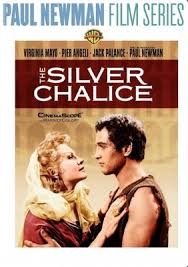
THE SILVER CHALICE
US, 1955, 142 minutes, Colour.
Virginia Mayo, Pier Angeli, Jack Palance, Paul Newman, Walter Hampden, Joseph Wiseman, Lorne Greene, E.G. Marshall, Michael Pate, Natalie Wood.
Directed by Victor Saville.
The Silver Chalice was based on a very popular biblical novel by Thomas B. Costain. However, the film version was greeted with some derision by critics – and later, Paul Newman, whose first film this was, took out a paid ad in Variety to apologise for the film and warn people not to see it.
However, it is one of the many popular biblical films of the period including The Robe, Demetrius and the Gladiators, The Prodigal. Virginia Mayo is at home in the role of the seductress Helene with Pier Angeli as the innocent leading lady. Jack Palance is Simon Magis, the character from the Acts of the Apostles. Paul Newman is Basil, a craftsman who has to shape the silver chalice with the faces of Jesus and the disciples. The supporting cast Walter Hampden as Joseph of Arimathea, Alexander Scourby as Saint Luke and Lorne Greene as Saint Peter.
The film is a typical biblical epic of the period, enjoyable tongue-in-cheek material. It was directed by Victor Saville, the British-born director whose last film this was. Saville had directed a number of interesting films in Britain in the 1930s including films for Jessie Matthews, Evergreen, Evensong. In going to the United States he directed The Green Years, Green Dolphin Street, If Winter Comes, Kim.
1. What was the overall impact of this film? What were its main successes? As history, as biblical drama, as a spectacular film?
2. The importance of the theme and its appeal? The cup of the Last Supper, the reverence for the cup, the nature of the silver chalice, the Holy Grail, the symbolism of a Christian quest? Was this evident?
3. The success of the commentary to introduce the film and take it through? Did this detract from involvement in the times? Was it important for reflection on the themes?
4. The quality of the wide screen colour spectacle, sets, the characteristics of the sets as being stylised rather than realistic? The musical background?
5. How interesting was the picture of Antioch twenty years after Christ? The nature of the place, pagan life, spread of Christianity? How convincing was this? The portrayal of Jerusalem, Roman influence, the Christians? The presentation of Rome in Nero's time, paganism? the role of the Christians, the Christians as scapegoats? Did the film give a rounded background of the time and places of early Christianity?
6. How interesting was the central character of Basil? As a boy, his art, the adoption? his role in society? The victim of a plot? Audience identification with him as a victimg as a craftsman, as a hero? The quality of Paul Newman's first performance? How interesting was Basil as a character? As a slave, in love with Helena, his relationship with the Christian Jews, his heroism for them?
7. The character of Ignatius as highlighting the life of Antioch? His place in rich society, his desire to adopt Basil, his plan being foiled by his brother?
8. Audience response to Basil's victimisation?
9. The introduction of Christianity via the character of Luke? Luke and his meekness? A convincing Christian? His inviting Basil to work for the Silver Chalice?
10. How interesting and attractive were the early Christians? The group in Jerusalem, the old man and his dying? The girl? The work for the Chalice? Basil's becoming involved in the Christians' life, love? His helping them to get money for the support of the preaching work?
11. The contrast with Simon? How interesting a character and villain was Simon? Jack Palance's sinister role? The magician, the performance of the tricks? His hold over Helena? His vanity and ambitions? His madness in wanting to become a new Messiah? his imitating of Christ, for example, Palm Sunday? His believing his own propaganda? his vanity in Rome? His practicality in preparing the tower, his dramatic obsession in wanting to fly? How moving and convincing was this finale?
12. The Sicarii: the zealot kind of Jew, their anti-Christian attitudes, their using of Simon, their pursuing of Basil to get the Chalice? The insight into this kind of Jewish Rebel?
13. How Interesting was the picture of Rome and Nero's court? Nero as ruler, as a fop, entertained by Simon, cruel in his ordering Helena's death? Was this a conventional picture of Rome? Or was there some insight?
14. The melodramatics of Basil and his flight to Rome, his fight in the desert with the Sicarii, the complications of emotions with Helena and his wife?
15. How interesting were the relationships between Basil, his wife and her danger for the death of the Roman etc and Helena's jealousy? Should more have been made of this?
16. How well did the film come to a climax with Simon and his death? Helena's death? Audience response to this? The irony of Basil and Helena as children - the way their life went?
17. How adequate was the happy ending of the film?
18. Could this film be described as religious? Were the film-makers religious in their attitude? Did it communicate a sense of religion? Religiosity?
Published in Movie Reviews
Published in
Movie Reviews
Tagged under
Saturday, 18 September 2021 19:43
Silk Stockings

SILK STOCKINGS
US, 1957, 117 minutes, Colour.
Fred Astaire, Cyd Charisse, Janis Paige, Peter Lorre, Jules Munshin.
Directed by Rouben Mamoulian.
Directed by Rouben Mamoulian and attractively photographed in Cinemascope, this is a remake of the 1939 film, Ninotchka.
Fred Astaire is the debonair lead in his usual entertaining manner. Cyd Charisse does a very good job as the Russian
emissary. Peter Lorre is most odd as one of the defectors to capitalism as does Jules Munshin, who was one of the main leads in On the Town. Janis Paige has a very entertaining satiric song about Cinemascope and Stereophonic sound. All in all, Silk Stockings is an attractive M.G.M. fifties musical and a second look at Ninotchka.
1. The quality of MGM musicals in the 40s and 50s? The nature of their appeal? Style, stars, song and dance, plot, decor and costumes? The quality of this musical?
2. The appeal of Fred Astaire and Cyd Charisse? Personalities, acting, dancing individually and combined?
3. The film as a re-make of Ninotchka? The memories of Greta Garbo, pre-war comedies, Russia and American attitudes in the 30s, 50s? Cyd Charisse in the Garbo role and her success with it? The 50s and the comic treatment of relationship with the Russians, of Communism? Cole Porter's music inserted into this plot? The incorporation of the ballet and dance styles? The making of the musical of this comedy?
4. The comparison of titles? The focus on Ninotchka in the past? On her reaction to France and the capitalist world in the later title? Symbolised with the ballet? The visuals?
5. The quality of the songs, music and especially lyrics, We’re not going back to Moscow, the love songs, the satire on Josephine, the humorous song on Cinemascope and Stereophonic sound, Satins and silks, the Red Blues, the Ritz roll and rock? Their incorporation into the plot. illustration of character? Satire and parody?
6. The quality of the dances - the initial dancing of Fred Astaire, Ninotchka’s instinct to dance and her dancing with him, her ballet in changing from Russian dress to French dress, the Cinemascope song and dance routine, the ballet with the red blues, the Ritz roll and rock and Fred Astaire's skill? The dancing as illustrating the spirit and theme of the film?
7. The portrayal of Russia and America and their role of world powers, their ideologies and themes of freedom, social concern, oppression, censorship? The humour of the clashes, the points made against each society, for? Humour and goodwill as a result of this kind of comedy about relationships?
8. Themes of utility versus beauty? Steve and his attitude towards life, joy, beauty? Ninotchka and her approach to the use of things? Their discussions about this, her finding love restful, the.humour of the tour of Paris? furnaces and the feeding of the poodles?
9. The popularity of Paris as the city of romance, capitalism? The ideals of the communist act within Paris? The effect of the climax? Emotions, relationships, fashion, wealth, beauty, joy, excess? The picturing of the three Russians at the beginning and the elaborate dancing and style of the Moscow song? The contrast of happiness in Paris with the memories of Russia? The going back to Russia and reminiscing? Their final escape and the setting
up of the cafe? How well did the film illustrate the contrast between Paris and Moscow?
10. The thenee of represeion and humn reaction to it? The three at the beginning and the wine, women and song - literally? The musician and his career, talent, wanting to stay, the attraction to Peggy? Ninotchka and her emotionless reactions, the looking at the silk stockings, the hiding of the clothes around the room, the fascination of Steve, Paris and the climate? Her previous efficient typing and not being able to? Her memories of Paris, the importance of the Red blues? Her returning and steeling herself, but her succumbing to the joy of Paris? The importance of the theme of repression and its reaction?
11. Themes of America, the films pro-American stances, the witness on freedom, the ability to love? Levels difficulty in getting a visa? The censoring of his letters? Themes against the Americans the gaudiness. the brashness, Peggy and her mindlessness, the treatment of the music for Josephine? How seriously were these anti-American themes to be taken? The humorous criticism of parody?
12. Where did the true seriousness of the film lie? In themes of human freedom, relationships?
13. The character of Steve and Fred Astaire’s style, the initial predentation of his feet, his dealing with the Russians, role as producer, dealing with Peggy and her drinking, falling in love with Ninotchka and guiding her around, his devices of getting to see her, drawing.her back to Paris?A pleasant American hero of an American musical?
14. The contrast with the character of Ninotchka? Her military aspects in Russia, her efficiency, the initial interview with Markovitch? Her arrival and attitude towards the three, towards the musician? Why did she change in Paris and how convincing was the change? Her femininity emerging? Her pining for Paris in Russia? Her hardness and not wanting to go back? The harshness at the end and her joy in meeting Steve again and the marriage?
15 The satire in the character of Peggy. the arrival of the American film star, her ignorance about War and Peace, her cliches liaisons and romance, her attitude towards music? The clever song parody in this characterisation? The cinemascore 'the satins and silk, Josephine? The infatuation of the Russian with Peggy?
16. The sly humour at film making and film making, types? The songs, the nature of American film making. American treatment of European culture, the final rock roll song?
17. The total effect of enjoyment of this musical, its lighter", aspects, the serious tone, politics, ideals, the work ethic? How well did the film combine the American light treatment with serious themes?
Published in Movie Reviews
Published in
Movie Reviews
Tagged under